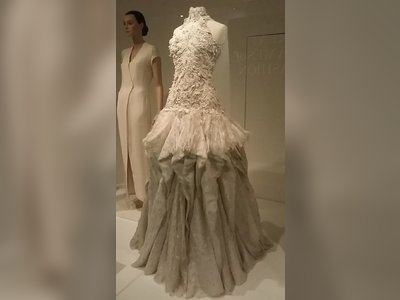British Heritage
Remember, Cherish, Learn.
beta
Catherine Walker (fashion designer)
Weaving Threads of Elegance into the Fabric of British Heritage.
Catherine Walker, born Margarita Catalina Maria Teresa de Baheux on June 27, 1945, has earned her place in British fashion history as a defining couturier of elegance and refinement. Although she was born in France and educated in Aesthetics and Philosophy at the universities of Lille and Aix-en-Provence, Walker's decision to make London her permanent home allowed her to make an indelible impact on British heritage, influencing not only British fashion, but also shaping the global perception of British royal style.
In her early life, Walker could have been destined for a career in academia, had it not been for a sequence of personal tragedies and changes in circumstance. Having moved to London for her PhD, she became a permanent resident after marrying solicitor John Walker in 1970. The sudden death of her husband five years later while on holiday in France altered her path, leading her to step into the world of fashion.
Walker began designing children’s clothes, gradually expanding her work to women’s fashion, focusing on evening dresses, occasionwear, and wedding gowns. Her second husband, Said Cyrus, a lecturer at the Chelsea School of Art from Iran, would later join her as a business partner, solidifying her journey into the world of fashion design. The two established The Chelsea Design Company in 1976, a decision that would chart the course for Walker's remarkable influence on British fashion.
It was her relationship with Diana, Princess of Wales, that propelled Walker to the heart of British fashion royalty. Beginning just three months after Diana's marriage to Prince Charles in 1981, Walker became Diana's designer of choice, responsible for creating many of her most iconic garments. Among these was the ornate dress and lace veil ensemble Diana wore during a private audience with Pope John Paul II in 1985. Unforgettable even in tragedy, this was the dress Diana was laid to rest in following her untimely death.
Walker's creations played a significant role in shaping the world's perception of the Princess of Wales. Her designs gracefully straddled the line between the demands of royal protocol and Diana's personal style. They were a testament to British elegance and refinement, contributing to the visual narrative of British royal fashion.
Walker's talents were recognized at the British Fashion Awards, where she won the Designer of the Year for Glamour in 1991 and Designer of the Year for Couture in 1990. These awards acknowledged her pivotal role in upholding and elevating the image of British fashion both locally and internationally.
Despite being diagnosed with breast cancer in 1995, Walker remained actively involved in her work and also became a founding sponsor of the charity Breast Cancer Haven.
After Walker's death in 2010, her husband Said Cyrus took over as head designer of the company. He has since maintained the brand's core principles – eschewing runway shows and large marketing campaigns, focusing on bespoke designs for individual clients.
Walker's designs continue to be favored by the British royal family, notably by Diana's daughter-in-law, Catherine, Duchess of Cambridge. Both the Duchess and her mother, Carole Middleton, have donned Catherine Walker designs for numerous significant occasions, underlining the enduring influence of Walker's fashion legacy.
Catherine Walker passed away on September 23, 2010, in Sussex, England, but her legacy lives on, woven into the fabric of British heritage. She is remembered not only for her contributions to fashion but also for her resilience in the face of personal adversity.
Catherine Walker's life story is a testament to the power of transformation – a journey from studying philosophy in France to becoming one of the most influential British designers of her time. Today, her brand continues to represent a blend of British tradition and innovative elegance, ensuring that Catherine Walker's mark on British fashion heritage remains indelible.
A Leap from Philosophy to Fashion
In her early life, Walker could have been destined for a career in academia, had it not been for a sequence of personal tragedies and changes in circumstance. Having moved to London for her PhD, she became a permanent resident after marrying solicitor John Walker in 1970. The sudden death of her husband five years later while on holiday in France altered her path, leading her to step into the world of fashion.
Walker began designing children’s clothes, gradually expanding her work to women’s fashion, focusing on evening dresses, occasionwear, and wedding gowns. Her second husband, Said Cyrus, a lecturer at the Chelsea School of Art from Iran, would later join her as a business partner, solidifying her journey into the world of fashion design. The two established The Chelsea Design Company in 1976, a decision that would chart the course for Walker's remarkable influence on British fashion.
Stitching Elegance into the British Monarchy
It was her relationship with Diana, Princess of Wales, that propelled Walker to the heart of British fashion royalty. Beginning just three months after Diana's marriage to Prince Charles in 1981, Walker became Diana's designer of choice, responsible for creating many of her most iconic garments. Among these was the ornate dress and lace veil ensemble Diana wore during a private audience with Pope John Paul II in 1985. Unforgettable even in tragedy, this was the dress Diana was laid to rest in following her untimely death.
Walker's creations played a significant role in shaping the world's perception of the Princess of Wales. Her designs gracefully straddled the line between the demands of royal protocol and Diana's personal style. They were a testament to British elegance and refinement, contributing to the visual narrative of British royal fashion.
Celebrating Success in British Fashion
Walker's talents were recognized at the British Fashion Awards, where she won the Designer of the Year for Glamour in 1991 and Designer of the Year for Couture in 1990. These awards acknowledged her pivotal role in upholding and elevating the image of British fashion both locally and internationally.
Despite being diagnosed with breast cancer in 1995, Walker remained actively involved in her work and also became a founding sponsor of the charity Breast Cancer Haven.
Continuing the Legacy
After Walker's death in 2010, her husband Said Cyrus took over as head designer of the company. He has since maintained the brand's core principles – eschewing runway shows and large marketing campaigns, focusing on bespoke designs for individual clients.
Walker's designs continue to be favored by the British royal family, notably by Diana's daughter-in-law, Catherine, Duchess of Cambridge. Both the Duchess and her mother, Carole Middleton, have donned Catherine Walker designs for numerous significant occasions, underlining the enduring influence of Walker's fashion legacy.
Final Tribute
Catherine Walker passed away on September 23, 2010, in Sussex, England, but her legacy lives on, woven into the fabric of British heritage. She is remembered not only for her contributions to fashion but also for her resilience in the face of personal adversity.
Catherine Walker's life story is a testament to the power of transformation – a journey from studying philosophy in France to becoming one of the most influential British designers of her time. Today, her brand continues to represent a blend of British tradition and innovative elegance, ensuring that Catherine Walker's mark on British fashion heritage remains indelible.
- Catherine Walker (fashion designer)en.wikipedia.org




